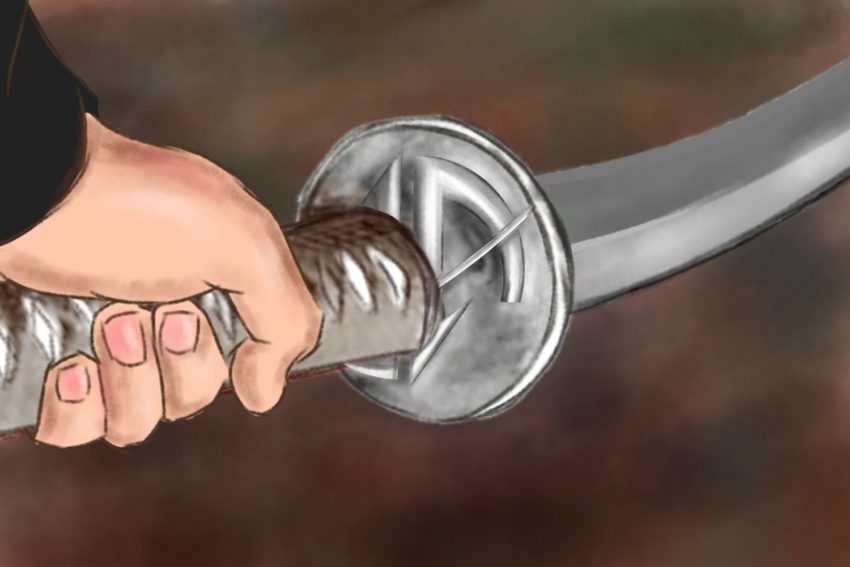People often collect the individual components of swords by themselves; they can be that attractive. There is a lot of variation when it comes to Japanese sword fittings and mountings. Certain aspects of sword mountings and fittings have developed over time and therefore look different or commonly use different materials. In addition, many elements are purely ornamental or can be decorated to say different things about a sword and its owner. The Japanese sword fittings and mountings chosen for your blade will reflect your own personal style and taste.
The mountings and fittings that accompany a Japanese blade truly are another aspect of the beauty, grace, and honor of Japanese swords. The craftsmanship that historically goes into the manufacture of each component represents an art in and of itself.
What Is “Koshirae”?
Koshirae is the word for the varying types of Japanese sword fittings and mountings, including the many elements that are required for a sword to be worn. Historically, the koshirae were often more ornate and striking because they were be worn proudly by their owners.
If you’re interested in Japanese sword fittings and in collecting katana and other swords, you should be familiar with the various types of koshirae you can choose from.
Tsuba: The Hand Guard
The tsubaTSUBA 鍔 "sword's hand guard" learn more... is the hand guard mounted on a Japanese sword, which would traditionally protect the hand of the sword wielder from an enemy attack and prevent the hand from sliding down along the edge of the sharp blade. It has either a circular or ovular shape and usually is made of brass or alloy. Most of the decorations on the tsuba would have been derived from religion, history, mythology, and nature.
If you’re looking to choose a tsuba for your own sword, consider a design that says something about you and your relationship with your sword or your collection of blades. Japanese sword fittings like the tsuba go a long way to making a piece your own.
History of Tsuba
In the early days of Japanese sword manufacture, this important element of a weapon would have been made by swordsmiths and armorsmiths. However, the manufacture of tsuba became a separate profession during the Muromachi Period. The Shoami family was one of the first main manufacturers of tsuba.
Types of Tsuba
Tsuba shapes and decorative elements varied over time and across different regions of Japan. Many collectors keep an eye out for authentic tsuba. They are mainly classified as either iron or soft metal. The perfect tsuba for you and your sword may be one of these familiar and classic types:
- Sukashi Tsuba
The Shoami family were the artisans responsible for this new design of tsuba. Many other artisans learned from the Shoami to develop even more designs. - Kinko Tsuba
The Edo period of Japan’s history, from around 1600 to 1867, was a time of relative peace and therefore more decorative sword fittings. - Tosho Tsuba
A type of tsuba made from steel, with a rounded outer ring. A relatively uncomplicated, utilitarian hand guard. - Katchushi Tsuba
This tsuba most likely received its name from the blossoms frequently found in the design. - Heianjo Tsuba
This type of tsuba was first created near the modern-day city of Kyoto. The body is round with brass designs in arabesque patterns, flowers, and family crests. - Kanaie Tsuba
This was from a group of tsuba makers during the Momoyama Period in Japan. They created the so-called efu style tusba, which featured engraved images of landscapes, people, and religious figures. The designs of this tsuba would commonly be inlaid with gold or silver.
Modern Tsuba Metal Choices
Nowadays, collectors can choose from a wide range of tsuba hand guards, in various metals. Alloy, iron, and brass are common tsuba materials.
Seppa: To Hold the Tsuba in Place
Seppa are washers that are used to tighten the fittings of a Japanese sword. They are placed in front and behind the tsuba. The seppa can either be ornamental or plain.
Tsuka: The Sword’s Handle
The tsuka is another important part of Japanese sword fittings: it’s the distinctive hilt or handle. Traditionally, the hilt of a Japanese sword is made from wood.
The Four Basic Shapes of a Tsuka
- Haichi Tsuka
This is the most common tsuka shape. The mune-side is very straight with a slightly tapered ha-side. In essence, the hilt shape follows the lines of the blade. - Rikko Tsuka
This tsuka has an hour glass shape. - Imogata
This tsuka literally means ‘potato shape.’ Both sides of the hilt are straight. - Morozori
This shape is mostly used with tachiTACHI 太刀 "great sword" learn more... and handachi swords. The shape of the hilt follows the shape of the scabbard.
Parts of the Tsuka
The tsuka of a Japanese sword also uses smaller components. Some of these are essential to properly wear the sword, but others are purely ornamental. Consider these Japanese sword fittings when looking at a piece for sale.
- Menuki
Menuki are attached in the center of the hilt. During the beginning of Japanese sword production, the menuki covered the pin that fastened the handle to the tang of the blade. Eventually this function was no longer necessary, but the menuki were retained for decorative purposes. They often featured elaborate designs. However, they did have the added bonus of helping someone to gain a comfortable grip on the handle of a sword. - Samegawa
The samegawa is the skin used to cover or wrap the handle. It is traditionally sharkskin or ray skin that is used to prevent the other wrappings (tsuka-ito) from slipping from the handle. - Tsuka-ito
The tsuka-ito is the wrapping of the tsuka, which would traditionally be silk. Today, cotton and occasionally leather are more common. Nowadays, collectors can choose different fabrics and colors to suit their tastes and style. The art of wrapping is called tsukamaki and is done using varying triangular designs. The process can be considered a task best done by a professional with years of experience for authentic Japanese swords. - Fuchi
The fuchi refers to the collar that covers opening in the tsuka. The tang of the blade goes into the opening in the fuchi. They are either simple metal bands, or highly crafted works of art. - Kashira
A kashira is the end cap or pommel of the tsuka. It does not have the purpose of a counter-balance as it would in a European sword. A kashira can be utilitarian or ornamental to degrees matching the rest of the Japanese sword fittings on a given weapon. - Habaki
A habaki is a small piece of brass collar that locks the tsuba in place and keeps the blade in the scabbard. It prevents the blade from sliding out of the scabbard when otherwise not being drawn for use or show.
Saya: The Sword’s Protective Scabbard
Saya is the Japanese word for scabbard. Traditionally, the scabbard of a Japanese sword would be in natural hard wood, ebony, or hualee wood. Additionally, the wood of the scabbard would be lacquered.
Parts of the Saya
There are several smaller components that traditionally make up the scabbard of a Japanese sword.
- Sageo
The sageo is a cord commonly wrapped and tied onto the scabbard. This cord would hold the scabbard tight on a belt and prevent it from slipping. It is also one of the most easily customizable parts of a Japanese sword. The sageo can be woven in intricate patterns with different colors to create a unique effect. - Kurikata
A kurikata refers to the knob that is attached to the scabbard. A hole in the kurikata is where the sageo is tied to the scabbard. - Kojiri
A kojiri is the protective end cap of the scabbard.
Small Knives Inserted Into the Saya
- Kogatana and Kozuka
Kogatana is a small utility knife that fits into a pocket in the scabbard. Not all Japanese swords would have kogatana. The kozuka is the decorative handle of a kogatana. These small knives would be polished on one side, with a sharpened edge on the other side. - Kogai
A kogai is a spike that can be used for hair arranging; it also fits into a pocket on the scabbard. Not all Japanese swords have kogai, but those that do often are paired with a matching kogatana on the opposite side of the scabbard. - Umabari
An umabari is another type of small knife that fits into a pocket on the scabbard. These types of knives were used to stimulate horses, and are also known as horse-needles.
Shirasaya: The “White Scabbard” Used for Storage
Shirasaya literally means “white scabbard” in Japanese and refers to a type of plain wooden mounting used for storage. A shirasaya is a much simpler version of other Japanese sword fittings and mountings. It only includes the scabbard and the hilt. They are also referred to as “resting scabbards” and are important to have after newly polishing a sword to prevent wear.
Traditionally, these Japanese fittings and mountings would use nurizaya wood. The purpose of the shirasaya was to store Japanese swords to avoid moisture buildup and corrosion that could be caused by keeping a blade in the laquered wood mountings of koshirae. Information about the blade might be written on the scabbard, but you should be wary of fraudulent information.
How to Choose Your Japanese Sword Fittings
Using the information on this page, you can get a great idea on the various types of mountings and fittings exist in the Japanese sword collecting world. Each of them can be chosen to suit your tastes and to contribute to the individuality of your piece. If you are looking at buying a sword from a vendor who sells weapons with different types of Japanese sword fittings, look carefully at each element before making your choice.
The possibilities for simplicity or ornateness, and for different types of material and designs, is a big part of the excitement of buying and owning a great Japanese sword.

